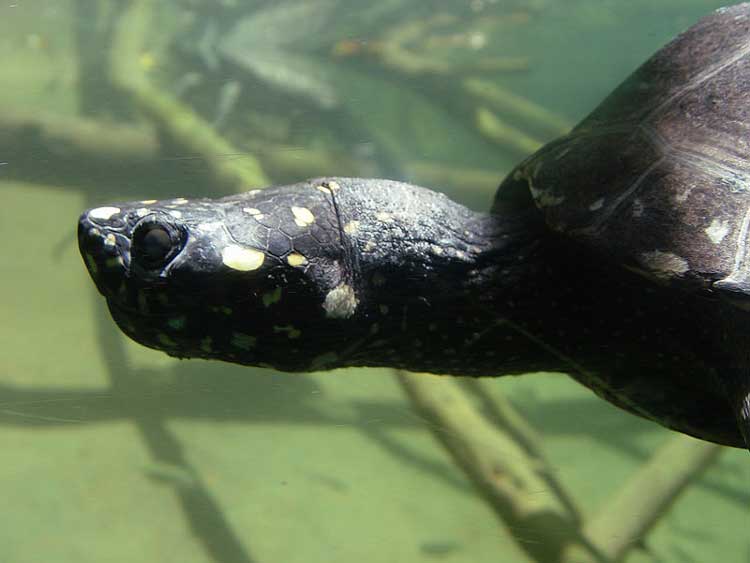
Geoclemys hamiltonii (*)
Superregnum: Eukaryota
Cladus: Unikonta
Cladus: Opisthokonta
Cladus: Holozoa
Regnum: Animalia
Subregnum: Eumetazoa
Cladus: Bilateria
Cladus: Nephrozoa
Superphylum: Deuterostomia
Phylum: Chordata
Subphylum: Vertebrata
Infraphylum: Gnathostomata
Megaclassis: Osteichthyes
Cladus: Sarcopterygii
Cladus: Rhipidistia
Cladus: Tetrapodomorpha
Cladus: Eotetrapodiformes
Cladus: Elpistostegalia
Superclassis: Tetrapoda
Cladus: Reptiliomorpha
Cladus: Amniota
Classis: Reptilia
Cladus: Eureptilia
Cladus: Romeriida
Subclassis: Diapsida
Cladus: Sauria
Cladus: Archelosauria
Division: Pan-Testudines
Division: Testudinata
Ordo: Testudines
Subordo: Cryptodira
Superfamilia: Testudinoidea
Familia: Geoemydidae
Subfamilia: Geoemydinae
Genus: Geoclemys
Species: G. hamiltonii
Name
Geoclemys hamiltonii (Gray, 1830)
Etymology: Species is named in appreciation after Francis Buchanan-Hamilton, Scottish physician who made significant contributions as a geographer, zoologist, and botanist while living in India.
Synonyms
Emys hamiltonii Gray, 1830
References
IUCN: Geoclemys hamiltonii (Gray, 1830) (Vulnerable)
Vernacular names
čeština: Želva Hamiltonova
English: Black Pond Turtle, Black Spotted Turtle, Hamilton's Terrapin, Spotted Pond Turtle
español: Galápago Rayado
français: Géoclemmyde D' Hamilton, Tortue De Hamilton
ไทย: เต่าแฮมิลตัน
The black pond turtle (Geoclemys hamiltonii), also known as the spotted pond turtle or the Indian spotted turtle, is a species of freshwater turtle endemic to South Asia.[4] It belongs to the monotypic genus Geoclemys.
Etymology
The specific name, hamiltonii, is in honor of Scottish botanist and ichthyologist Francis Hamilton.[5]
Description
G. hamiltonii is mainly black with small yellowish or white spots, and a much-elevated carapace, with three interrupted keels or series of nodose prominences corresponding to the vertebral and costal shields. The posterior border of the carapace is strongly serrated in young, but feebly in the adult. The nuchal is moderate, broader posteriorly than anteriorly. The first vertebral is not or scarcely broader anteriorly than posteriorly. The second and third vertebrals are broader than long in the young, nearly as long as broad in the adult, narrower than the costals. The plastron is large, angulate laterally, truncate anteriorly. The posterior lobe of the plastron is much narrower than the opening of the shell, nearly as long as the width of the bridge, deeply notched posteriorly. The head is rather large. The snout is very short, not projecting. The upper jaw is emarginated mesially. The width of the mandible at the symphysis nearly equals the horizontal diameter of the orbit. A large shield covers the upper surface of the snout and the crown, sometimes divided into three, one shield around the upper jaw and one on each side between the eye and the ear. The digits are webbed to the claws. The tail is extremely short. The shell is dark brown or blackish, elegantly marked with yellow spots and radiating streaks, and the soft parts are dark brown or blackish, with round yellow spots, largest on the head and neck.[6]
Maximum straight carapace length is 41 cm (16 in).[7]
Geographic range
G. hamiltonii is found in southern Pakistan (Indus and Ganges River drainages), northeastern India (Assam), Sri Lanka, and Bangladesh.
References
Praschag, P.; Ahmed, M.F.; Singh, S. (2019). "Geoclemys hamiltonii". IUCN Red List of Threatened Species. 2019: e.T9029A152050337. doi:10.2305/IUCN.UK.2019-1.RLTS.T9029A152050337.en. Retrieved 19 November 2021.
"Appendices | CITES". cites.org. Retrieved 2022-01-14.
Fritz, Uwe; Havaš, Peter (2007). "Checklist of Chelonians of the World" (PDF). Vertebrate Zoology. 57 (2): 222. ISSN 1864-5755. Archived from the original (PDF) on 2011-05-01. Retrieved 29 May 2012.
Chelonia.org
Beolens, Bo; Watkins, Michael; Grayson, Michael (2011). The Eponym Dictionary of Reptiles. Baltimore: Johns Hopkins University Press. xiii + 296 pp. ISBN 978-1-4214-0135-5. (Geoclemys hamiltonii, p. 114).
Boulenger GA (1890). The Fauna of British India, Including Ceylon and Burma. Reptilia and Batrachia. London: Secretary of State for India in Council. (Taylor and Francis, printers). xviii + 541 pp. (Damonia hamiltonii, p. 34).
Das (2002).
Further reading
Das I (2002). A Photographic Guide to Snakes and other Reptiles of India. Sanibel Island, Florida: Ralph Curtis Books. 144 pp. ISBN 0-88359-056-5. (Geoclemys hamiltonii, p. 125).
Gray JE (1831). Synopsis Reptilium or Short Descriptions of the Species of Reptiles. Part I: Cataphracta, Tortoises, Crocodiles, and Enaliosaurians. London: Treuttel, Wurz & Co. 85 pp. (Emys hamiltonii, new species, pp. 21, 72).
Khan, Mohammad Ali Reza (1982). "Chelonians of Bangladesh and their conservation". J. Bombay Nat. Hist. Soc. 79 (1): 110-116 + Plates I-II. (Geoclemys hamiltoni, p. 113).
Murray JA (1884). "Additions to the reptilian fauna of Sind". Ann. Mag. Nat. Hist., Fifth Series 14: 106–111.
Philippen H-D (2004). "Geoclemys hamiltonii (Gray 1831) - Strahlen-Dreikielschildkröte ". Reptilia (Münster) 9 (5): 51–54. (in German).
Smith MA (1931). The Fauna of British India, Including Ceylon and Burma. Reptilia and Amphibia. Vol. I.—Loricata, Testudines. London: Secretary of State for India in Council. (Taylor and Francis, printers). xxviii + 185 pp. + Plates I-II. (Geoclemys hamiltoni, pp. 111–112 + Plate I, figure 6).
Retrieved from "http://en.wikipedia.org/"
All text is available under the terms of the GNU Free Documentation License

